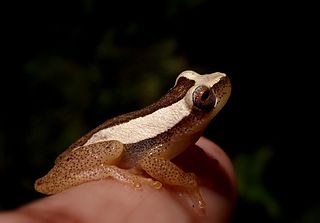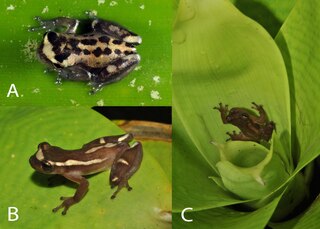Dendropsophus aperomeus is a species of frog in the family Hylidae. It is endemic to Peru and occurs on the Amazonian slopes of the Andes in northern and central Peru. Common name Balzapata treefrog has been coined for it.
Dendropsophus berthalutzae is a species of frog in the family Hylidae. It is endemic to southeastern Brazil and occurs in the coastal lowlands and the Serra do Mar in Espírito Santo, Minas Gerais, Rio de Janeiro, São Paulo, and eastern Paraná states. It is named in honor of Bertha Lutz, a Brazilian zoologist and feminist. Common name Bertha's treefrog has been coined for it.

Dendropsophus bogerti is a species of frog in the family Hylidae. It is endemic to the Andes of Colombia and occurs in the Cordillera Central in Antioquia, Caldas, and Chocó Departments. The specific name bogerti honors Charles Mitchill Bogert, an American herpetologist. Soon after its description in 1970, it was relegated to synonymy of Dendropsophus carnifex, but its species status was restored in 1997.

Dendropsophus ebraccatus, also known as the hourglass treefrog or pantless treefrog, is a neotropical treefrog, found scattered throughout Central and South America from southern Mexico to northern Ecuador. The common names of D. ebraccatus come from the dark hourglass shaped pattern found in the centre of the back and the distinct smooth yellow thighs that contrast the rest of the brazenly patterned body. The contrasting of the smooth yellow thighs from the rest of the bodies pattern provide the illusion that D. ebraccatus is not wearing pants. The name ebraccata in Latin means "without trousers". D. ebraccatus has a number of unique reproductive features, such as the ability to alter rates of hatching shared in a number of Anura families. D. ebraccatus is also unique in its ability to alter its mode of reproduction as it is the only known vertebrate to be able to do so.
Dendropsophus garagoensis is a species of frog in the family Hylidae. It is endemic to the eastern slope of the Cordillera Oriental in Boyacá Department, Colombia. Common name Garagoa treefrog has been proposed for it.

Dendropsophus haddadi is a species of frog in the family Hylidae. It is endemic to eastern Brazil, with its distribution ranging from northern Espírito Santo to Bahia, Sergipe, Alagoas, Pernambuco. The specific name haddadi honors Célio F. B. Haddad, a Brazilian ecologist and herpetologist.

Dendropsophus joannae is a species of frogs in the family Hylidae. It is known from the Pando Department, northern Bolivia, western Brazil, and Madre de Dios Region of southeastern Peru. It is similar to Dendropsophus leali but is smaller, has a shorter snout, more protuberant eyes, and more tuberculate dorsal skin. The specific name joannae honors Mrs. Jo Ann Oxley Foster, a BIOPAT patron supporting taxonomic research and nature conservation.
Dendropsophus riveroi is a species of frog in the family Hylidae. It is found in the upper Amazon Basin in western Brazil, Bolivia, Peru, Ecuador, and southern Colombia. In Ecuador it has been mixed with the newly described Dendropsophus shiwiarum. The specific name honours Juan A. Rivero.

Dendropsophus robertmertensi is a species of frog in the family Hylidae. It is found in the Pacific lowlands of El Salvador, Guatemala, and southeastern Mexico. A separate population exists in the Cintalapa Valley in Chiapas.
Dendropsophus stingi is a species of frogs in the family Hylidae. It is endemic to Colombia and occurs on the eastern slope of the Cordillera Oriental in the Boyacá Department. The species was named after celebrity musician Sting in recognition of his "commitment and efforts to save the rain forest". Despite this, common name Kaplan's Garagoa treefrog has been coined for it.

Phrynobatrachus minutus is a species of frog in the family Phrynobatrachidae. It is endemic to Ethiopia and occurs in the central and southern parts of the country on both sides of the Rift Valley; its range may extend south to Kenya, perhaps further. Some earlier records from Ethiopia represent Phrynobatrachus inexpectatus, described as a new species in 2001. The specific name minutus refers to the small size of this frog. Common names tiny river frog and Ethiopian dwarf puddle frog have been coined for it.

Dendropsophus arndti is a species of "clown tree frogs" described in 2017 that lives in the Amazon basin of Bolivia. The specific name arndti honors professor Rudolf G. Arndt, in recognition of his financial support for research and nature conservation.
The reticulated tree frog is a species of frog in the family Hylidae. It lives in Bolivia, Peru, Ecuador and Colombia. It has been reported between 40 and 1037 meters above sea level.
Dendropsophus frosti, the acre tree frog, is a frog in the family Hylidae. It is endemic to in South America. Scientists have seen it at two sites, one in Colombia and one in Peru.
Dendropsophus counani is a frog in the family Hylidae. It is endemic to Brazil, French Guiana, Suriname, and Guyana.
Sphaenorhynchus mirim is a frog. Scientists have seen it in one place: Fazenda Gemada in Brazil.
Dendropsophus rozenmani is a frog in the family Hylidae endemic to Bolivia.
Boana ventrimaculata, The Yasuní tree frog, is a frog in the family Hylidae, endemic to Ecuador and Brazil. Scientists have seen it between 64 and 1035 meters above sea level.
Dendropsophus reichlei is a frog in the family Hylidae endemic to Bolivia, Peru, and Brazil.

Dendropsophus bromeliaceus, or Teresensis' bromeliad frog, is a frog in the family Hylidae, endemic to Brazil. Scientists have only seen it in the mountains in the Reserva Biológica Augusto Ruschi.\







